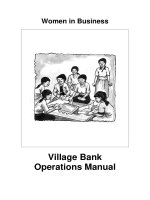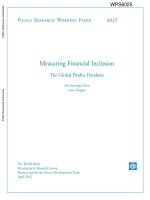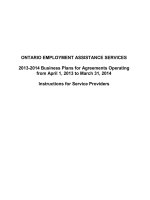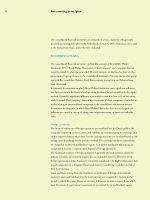Measuring Business Income: The Adjusting Process potx
Bạn đang xem bản rút gọn của tài liệu. Xem và tải ngay bản đầy đủ của tài liệu tại đây (229.41 KB, 48 trang )
Measuring Business
Income:
The Adjusting Process
Chapter
3
Distinguish accrual
accounting from
cash-basis accounting.
Objective 1
Accrual-basis:
Transactions are
recorded
when revenues are
earned or expenses
are incurred.
Cash-basis:
Transactions are
recorded when
cash is paid or
cash is received.
The Two Bases of Accounting:
Accrual Versus Cash Example
✔
In January 2002, Prensa Insurance sells
a three-year health insurance policy to a
business client.
✔
The contract specifies that the client had
to pay $150,000 in advance.
✔
Yearly expenses amount to $20,000.
✔
What is the income or loss?
Accrual Versus Cash Example
Accrual-Basis Accounting
2002 2003 2004
(000 omitted)
Revenues $50 $50 $50
Expenses 20 20 20
Net income (loss) $30 $30 $30
Accrual Versus Cash Example
Cash-Basis Accounting
2002 2003 2004
(000 omitted)
Cash inflows $150 $ 0 $ 0
Cash outflows 20 20 20
Net income (loss) $130 ($20) ($20)
Managers adopt an
artificial period of time
to evaluate performance.
Accounting Period
Monthly
Quarterly
Semi-annually
Interim Period Statements
Apply the revenue and
matching principles.
Objective 2
Revenue Principle
✔
When is revenue recognized?
✔
When it is deemed earned.
✔
Recognition of revenue and cash receipts
do not necessarily occur at the same time.
The Matching Principle
✔
What is the matching principle?
✔
It is the basis for recording expenses.
✔
Expenses are the costs of assets and the
increase in liabilities incurred in the earning
of revenues.
✔
Expenses are recognized when the benefit
from the expense is received.
Matching Expenses with
Revenues Example
✔
Parker Floor sells a wood floor for $15,000
on the last day of May.
✔
The wood was purchased from the
manufacturer for $8,000 in March of the
same year.
✔
The floor is installed in June.
✔
When is income recognized?
Revenues $15,000
Cost of goods sold 8,000
Net income $ 7,000
May
Matching Expenses with
Revenues Example
Interacts with the
revenue principle and
the matching principle
Requires that income
be measured
accurately each period
The Time Period Concept
✔
It requires that accounting information be
reported at regular intervals.
Make adjusting entries.
Objective 3
Adjusting Entries
✔
Assign revenue to the period earned.
✔
Assign expenses to the period incurred.
✔
Bring related asset and liability accounts
into correct balance.
Prepaids or Deferrals
Accruals
Two Types Of
Adjusting Entries
Prepaid expenses
Depreciation
Accrued expenses
Accrued revenues
Unearned revenues
Five Categories Of
Adjusting Entries
24,000
CashPrepaid Insurance
24,000
Prepaid Insurance Example
On January 2, 2005, Parker Floor paid $24,000
for a two-year health insurance policy.
On January 2, 2005, Parker Floor paid $24,000
for a two-year health insurance policy.
Prepaid Insurance Example
✔
What is the journal entry on December 31,
2005?
✔
Dec. 31, 2005
Insurance Expense 12,000
Prepaid Insurance 12,000
To record insurance expense
Time
Prepaid Insurance Example
✔
What was the determining factor in
matching this expense?
Supplies Example
✔
Wood Enterprise started business the
beginning of the month.
✔
$800 worth of office supplies were
purchased on November 15, 2004, for cash.
Office Supplies Cash
800 800
An inventory at month end indicated
that $200 in office supplies remained.
What is the supplies expense?
An inventory at month end indicated
that $200 in office supplies remained.
What is the supplies expense?
Supplies Example
Usage
Supplies Expense
600
Supplies
800 600
Bal. 200
Supplies Example
What was the determining factor
in matching this expense?
Depreciation Example
✔
On January 2, Wood Enterprise purchased
a truck for $30,000 cash.
✔
The truck is expected to last for 3 years.









